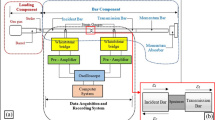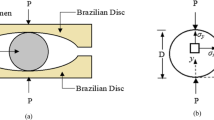Abstract
Three high-performance concrete (HPC) materials with different specimen geometries were characterized using Kolsky compression bar techniques to study the strain rate and specimen size effects on their uniaxial compressive strength. A large-diameter Kolsky bar and recently established annular pulse shaping technique were used to achieve dynamic stress equilibrium and constant strain-rate deformation in the experiments. A complimentary effort was conducted using a 19-mm-diameter Kolsky compression bar to understand the strain rate and specimen size effects on failure strength and dynamic increase factor (DIF) for concrete. It was found that, for all three concrete materials investigated, the failure strength is highly dependent on the specimen geometry, however such a relationship is not apparent for the DIF. The DIF observed in this study shows significantly lower values compared to historical data, which may indicate the importance of well-controlled dynamic testing conditions on the accuracy and validity of experimental results for concrete materials.











Similar content being viewed by others
References
Kesler CE, Naus DJ, Lott JL (1971) Fracture mechanics-its applicability to concrete. Proc. Int. Conf. Mechanical behavior of materials, vol. IV, 1972, pp 113–124. The Soc. Mater. Sci. Kyoto
Leicester RH (1969) The size effect of notches. Proc. 2nd Australasian Conference on Mechanics of Structural. Materials, pp 4.1–4.20, Melbourne
Walsh PF (1972) Fracture of plain concrete. Indian Concrete Journal 46(11)
Walsh PF (1976) Crack initiation in plain concrete. Mag Concr Res 28:37–41
Bazant ZP (1984) Size effect in blunt fracture: concrete, rock, metal. Journal of Engineering Mechanics, ASCE 110:518–535
Bazant ZP (1999) Size effect on structural strength: a review. Arch Appl Mech 69:703–725
Zhou FP, Balendran RV, Jeary AP (1998) Size effect on flexural, split tensile, and torsional strengths of high-strength concrete. Cem Concr Res 28:1725–1736
Issa SA, Islam MS, Issa MA, Yousif AA, Issa MA (2000) Specimen and aggregate size effect on concrete compressive strength. Cement, Concrete and Aggregates 22:103–115
Kim JK, Yi ST (2002) Application of size effect to compressive strength of concrete members. Sadhana 27:467–484
Ince R, Arici E (2004) Size effect in bearing strength of concrete cubes. Constr Build Mater 18:603–609
Yazici S, Sezer GI (2007) The effect of cylindrical specimen size on the compressive strength of concrete. Build Environ 42:2417–2420
del Viso JR, Carmona JR, Ruiz G (2008) Shape and size effects on compressive strength of high-strength concrete. Cem Concr Res 38:386–395
Udoeyo FF, Brooks R, Udo-Inyang P, Kehinde AM (2010) Influence of specimen geometry on the strengths of laterized concrete. International Journal of Research and Reviews in Applied Science 3:8–17
Rao MVK, Kumar PR, Srinivas B (2011) Effect of size and shape of specimen on compressive strength of glass fiber reinforced concrete (GFRC). Architecture and Civil Engineering 9:1–9
Che Y, Ban S, Cui J, Chen G, Song Y (2011) Effect of specimen shape and size on compressive strength of concrete. Adv Mater Res 163-167:1375–1379
Al-Sahawneh EI (2013) Size effect and strength correction factors for normal weight concrete specimens under uniaxial compression stress. Contemporary Engineering Sciences 6:57–68
Zi G, Kim J, Bazant ZP (2014) Size effect on biaxial flexural strength of concrete. ACI Mater J 111:1–8
Kim JK (1990) Size effect in concrete specimens with dissimilar initial cracks. Mag Concr Res 42(153):233–238
Bazant ZP, Xiang Y (1997) Size effect in compression fracture: splitting crack band propagation. J Eng Mech 123:162–172
Watstein D (1953) Effect of straining rate on the compressive strength and elastic properties of concrete. ACI Journal Proceedings 49(4):729–744
Goldsmith W, Kenner VH, Ricketts TE (1966) Dynamic behavior of concrete. Exp Mech 66:65–69
Hughes BP, Gregory R (1972) Concrete subjected to high rates of loading in compression. Mag Concr Res 24:25–36
Ross CA, Thompson PY, Tedesco JW (1989) Split-Hopkinson pressure-bar tests on concrete and mortar in tension and compression. ACI Mater J 86:475–481
Bischoff PH, Perry SH (1991) Compressive behavior of concrete at high strain rates. RIELM Mater Struct 24:425–450
Ross CA, Jerome DM, Tedesco JW, Hughes ML (1996) Moisture and strain rate effects on concrete strength. ACI Mater J 93:293–300
Grote DL, Park SW, Zhou M (2001) Dynamic behavior of concrete at high strain rates and pressures: I. Experimental characterization. Int J Impact Eng 25:869–886
Reinhardt HW (1982) Concrete under impact loading: tensile strength and bond. HERON 27(3):1–48
Cadoni E, Albertini C, Solomos G (2006) Analysis of the concrete behavior in tension at high-strain rate by a modified Hopkinson bar in support of impact resistant structural design. J Phys IV France 134:647–652
John R, Antoun T, Rajendran AM (1991) Effect of strain rate and size on tensile strength of concrete. Shock Compression of Condensed Mater In: Schmidt SC, Dick RD, Forbes JW, Tasker DG (eds) Elsevier, amsterdam, pp 501–504
Lambert DE, Ross CA (2000) Strain rate effects on dynamic fracture and strength. Int J Impact Eng 24:985–998
Klepacako JR, Brara A (2001) An experimental method for dynamic tensile testing of concrete by spalling. Int J Impact Eng 25:387–409
Erzar B, Forquin P (2010) An experimental method to determine the tensile strength of concrete at high rates of strain. Exp Mech 50:941–955
Malvar LJ, Crowford JE (1998) Dynamic increase factors for concrete. Twenty-Eighth DDESB Seminar, Orlando
Li QM, Meng H (2003) About the dynamic strength enhancement of concrete-like materials in a split Hopkinson pressure bar test. Int J Solids Struct 40:343–360
Heard WF, Martin BE, Nie X, Slawson T, Basu PK (2014) Annular pulse shaping technique for large-diameter Kolsky bar experiments on concrete. Exp Mech 54:1343–1354
Heard WF (2014) Development and multi-scale characterization of a self-consolidating high-strength concrete for quasi-static and transient loads. Vanderbilt University
Williams EM, Graham SS, Reed PA, Rushing TS (2009) Laboratory characterization of Cor-Tuf concrete with and without steel fibers. ERDC/GSL TR 09–22, U.S. Army Engineer Research and Development Center
Daczko JA (2012) Self-consolidating concrete. CRC Press, Boca Raton
O’Neil EF (2008) On engineering the microstructure of high-performance concretes to improve strength, rheology, toughness, and frangibility. Northwestern University
Ranade R, Li VC, Heard WF, Williams BA (2017) Impact resistance of high strength-high ductility concrete. Cem Concr Res 98:24–35
Duffy J, Campbell JD, Hawley RH (1971) On the use of a torsional split Hopkinson bar to study rate effects in 1100-0 aluminum. ASME Trans J Appl Mech 37:83–91
Chen W, Song B (2011) Split Hopkinson (Kolsky) bar: design, testing and applications. Springer, Berlin
Nemat-Nasser S, Issac JB, Starrett JE (1991) Hopkinson techniques for dynamic recovery experiments. Proc R Soc Lond A 435(1894):371–391
Frew DJ, Forrestal MJ, Chen W (2001) A split Hopkinson bar technique to determine compressive stress-strain data for rock materials. Exp Mech 41:40–46
Frew DJ, Forrestal MJ, Chen W (2002) Pulse shaping techniques for testing brittle materials with a split Hopkinson pressure bar. Exp Mech 42:93–106
Warren T, Forrestal MJ (2010) Comments on the effect of radial inertia in the Kolsky bar test for an incompressible material. Exp Mech 50:1253–1255
ASTM C42M-13 (2013) Standard test method for obtaining and testing drilled cores and sawed beams of concrete. ASTM International, West Conshohocken
ASTM C39M-04 (2004) Standard test method for compressive strength of cylindrical concrete specimens. ASTM International, West Conshohocken
Acknowledgements
Dr. Xu Nie gratefully acknowledges financial support from the U.S. Air Force Research Laboratory (AFRL) under agreement number FA8651-14-2-0007, and the U.S. Army Engineer Research and Development Center (ERDC) under contract number W912HZ-14-C-0021. The authors would also like to acknowledge the Center for Advanced Research and Technology at University of North Texas for access to the experimental facilities used for this study. Permission to publish was granted by the Directors of the Air Force Research Laboratory and ERDC Geotechnical and Structures Laboratory.
Author information
Authors and Affiliations
Corresponding author
Rights and permissions
About this article
Cite this article
Martin, B.E., Heard, W.F., Loeffler, C.M. et al. Specimen Size and Strain Rate Effects on the Compressive Behavior of Concrete. Exp Mech 58, 357–368 (2018). https://doi.org/10.1007/s11340-017-0355-2
Received:
Accepted:
Published:
Issue Date:
DOI: https://doi.org/10.1007/s11340-017-0355-2




